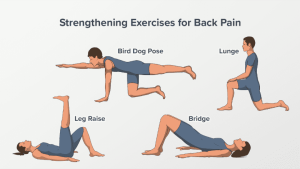
Chronic back pain is one of the most common health complaints worldwide, affecting millions of people and significantly reducing quality of life. While medications and treatments offer temporary relief, research consistently shows that regular exercise plays a critical role in preventing and managing chronic back pain.
In this article, we’ll explore how exercise strengthens the spine, reduces pain, and improves overall health. We’ll also outline specific exercises and tips for creating a sustainable fitness routine to protect your back for the long term.
Chronic back pain is defined as pain that persists for 12 weeks or longer, even after the initial cause has been treated. Unlike acute back pain caused by sudden injury, chronic pain often stems from ongoing stress, poor posture, weak muscles, or degenerative changes in the spine.

Several factors contribute to chronic back pain, including:
Your core, including the abdominal, back, and pelvic muscles, acts as a natural brace for your spine. Strong core muscles stabilize the spine, improve posture, and reduce the risk of injuries. Exercises like planks, bridges, and Pilates target these muscles effectively.
Flexible muscles and ligaments allow your spine to move freely without strain. Stretching exercises, yoga, and mobility routines help maintain flexibility in the hips, hamstrings, and lower back, reducing tension and pain.
Regular exercise increases circulation, delivering oxygen and nutrients to the spinal tissues. Improved blood flow supports healing, reduces inflammation, and prevents stiffness that can lead to chronic pain.
Maintaining a healthy weight is crucial for reducing stress on the spine. Cardiovascular exercises like walking, swimming, or cycling help burn calories, prevent weight gain, and protect your lower back from excess strain.
A strong core provides stability and reduces pressure on the spine. Recommended exercises include:
Flexibility exercises relieve tension and improve range of motion:
Low-impact cardio improves circulation without stressing the spine:
Good posture prevents spinal misalignment and chronic pain. Balance exercises enhance coordination and reduce the risk of falls:
If you’re new to exercise or returning after back pain, begin with low-intensity workouts and gradually increase duration and intensity. Sudden movements or overexertion can worsen back pain.
Proper form is critical to prevent injury. Use mirrors, consult fitness professionals, or follow instructional videos to ensure you’re performing exercises correctly.
Mix strength training, cardio, flexibility, and posture exercises to provide comprehensive support for your spine. A varied routine reduces repetitive strain and keeps workouts engaging.
Pain is a warning sign. Mild discomfort from stretching is normal, but sharp or worsening pain should prompt you to stop and consult a healthcare professional.
Regular exercise, even in short daily sessions, is more effective than occasional intense workouts. Consistency strengthens the spine over time and prevents chronic pain from developing.
Combine exercise with balanced nutrition to reduce spinal stress and lower the risk of back pain. Diets rich in calcium, vitamin D, and lean protein support bone and muscle health.
Proper desk setup, supportive chairs, and lifting techniques prevent unnecessary strain on the back during daily activities.
Chronic stress can lead to muscle tension and pain. Mind-body exercises like yoga, tai chi, or meditation help relieve tension and support spinal health.
While exercise is highly effective for preventing chronic back pain, consult a doctor or physical therapist if you experience:
A professional can assess your condition, recommend specific exercises, and help prevent further injury.
Exercise is one of the most effective ways to prevent chronic back pain. By strengthening your core, improving flexibility, maintaining cardiovascular health, and practicing good posture, you can protect your spine and enjoy a more active, pain-free life.
Consistency, proper technique, and a balanced approach are essential. Combine exercise with healthy lifestyle choices, and you’ll not only reduce your risk of chronic back pain but also improve overall well-being and longevity.